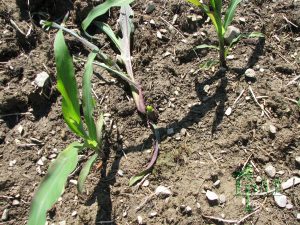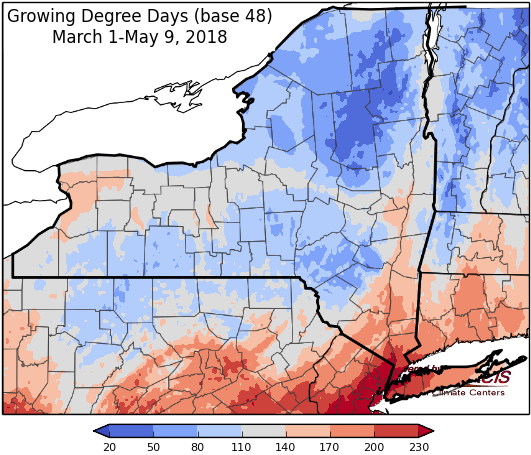Contents
Welcome Back and Some Changes!
Welcome back to the 17th year of the NYS IPM Field Crops Weekly Pest Report. The format will be a little different this year. We will continue to have the “View from the Field” on what is happening with pests across the state weekly. We will also have the weather outlook, degree day models, IPM Clipboard Checklist, Fusarium Head Blight Update and other weekly updates. To make the weekly report shorter most of the specific longer pest articles will be on a permanent link. Links to specific pest information will be provided within the report as needed for that time of the season and when it has been detected in NY. Much of the information provided in the report will also the available on the NYS IPM Facebook page and my Twitter account: https://twitter.com/NYSFieldCropIPM We are trying to keep the report short and give you what you need for each pest problem.
View from the Field
Field work has started this week. We have a pheromone trapping network for black cutworm and true armyworm moth migrations into New York from the south. We have caught low numbers of black cutworm moths in NY except for one trap in Western NY that caught 35 last week. As corn starts to emerge from the soil watch for the classic cut corn plants at the base. This is a sign of black cutworm.
We have caught very low numbers of true armyworm so for this season. As we continue to get weather fronts the risk of these pests will increase.
IPM for Black Cutworm in Field Corn
Mike Stanyard (Field Crop Specialist: CCE NW NY Dairy and Field Crops Team) reports scouting alfalfa weevil damage in alfalfa. Currently it is not at an economic threshold.
IPM for Alfalfa Weevil in Alfalfa
Mike has also seen cereal leaf beetle adults in small grains this last week. While adults do feed on leaves the larvae do most of the damage. See the following article cereal leaf beetle.
IPM for Cereal Leaf Beetle in Small Grains
Weather Outlook – May 10, 2018
Jessica Spaccio
NOAA Northeast Regional Climate Center, Cornell University
Last week temperatures ranged from 4 to 10 degrees above normal. Precipitation has ranged from a trace to near two inches. Base 50 growing degree-days ranged from 10-110.
Temperatures will warm to above-normal today before a cold front passes bringing showers and cooler temperatures.
Today temperatures will be in the low to mid 70’s with showers likely and thunderstorms possible as a cold front passes. Overnight lows will be in the 40’s.
Friday temperatures will be much cooler behind the cold front, ranging from the 50’s to low 60’s for most areas, reaching mid- to upper 60’s in southeast NY. Conditions will by sunny and dry before scattered showers return in the evening into Saturday. Overnight temperatures will be in the 40’s, dipping into the 30’s in northern areas.
Saturday temperatures will range from the upper 50’s in northern areas to mid 70’s in central NY. Conditions will be cloudy with light rain possible. Overnight temperatures will be in the mid 40’s to mid 50’s.
Sunday will have highs in the mid 60’s to low 70’s. Light rain is possible early, with drying conditions throughout the day. Overnight temperatures will be in th 40’s.
Monday will be sunny with highs in the low to mid 70’s. Lows will be in the 40’s.
Tuesday will be sunny with highs in the 70’s. Lows will be in the upper 40’s to low 50’s.
Wednesday, temperatures will be in the 70’s with showers possible. Lows will be in the 50’s.
The seven-day precipitation amounts will range from half an inch to near two inches.
The 8-14 day outlook (May 17-23) favors above-normal temperatures for the state. The precipitation outlook slightly favors above-normal precipitation for a majority of the state.
National Weather Service watch/warnings map
Degree Day Maps
Degree Day Life Stages for Alfalfa Weevil
Clipboard Checklist
Keith Waldron, NYS IPM
General
*Walk fields to check tile flow, check and clear drainage outlets. Look for line breaks
*Note and record location of wet areas on field maps or aerial photo for future tiling considerations and crop decisions, check for areas of soil erosion
*Pre-plant weed evaluation, timing cultivation and/or pre-plant weed management
*Watch for early season weeds: winter annuals, chickweed, henbit, field penny cress, shepherd’s purse, giant and common ragweed, purple deadnettle, lambsquarters, redroot pigweed, velvet leaf, Pennsylvania smartweed, common sunflower, quackgrass, foxtail
Alfalfa:
*Evaluate established legume stands for winter damage (thinning stand, frost heave, brown root rot), determine average alfalfa stand count adjust crop plans if necessary
*Monitor for alfalfa weevil
*Monitor new seedings for Pythium blight and Phytopthora Root Rot.
*Monitor for Alfalfa Snout Beetle (In Oswego, Jefferson, Cayuga, Wayne, Lewis, St. Lawrence, Clinton, Essex, and Franklin counties)
Small Grains:
*Monitor winter grain fields for over wintering survival (snow mold and other cold injury issues), weed issues (such as winter annuals, corn chamomile and chickweed), growth stage, number of tillers
*Check stands for soilborne virus diseases, Wheat spindle streak mosaic and Soilborne wheat mosaic, check for signs of powdery mildew or other maladies, cereal leaf beetle, weed escapes, goose damage
Corn:
*Prepare land and plant corn as conditions allow
*Pre-plant weed evaluation, timing cultivation and/or pre-plant weed management
Soybeans:
*Prepare land and plant soybeans as conditions allow
*Pre-plant weed evaluation, timing cultivation and/or pre-plant weed management
Pastures:
*Check and mend fences as needed.
*Check crop growth
*Monitor fields for invasive species, plants harmful to livestock
*Review/Plan rotation system
Equipment:
*Remove / clean soil and crop debris from equipment
*Arrange for custom weed control or check your own application or cultivator equipment for repairs.
*Carry appropriate / necessary NYS DEC and EPA required documents: (pesticide applicators license, pesticide labels, MSDS sheets, etc.) with application equipment
*Calibrate:
-planting equipment – maintain records on planting rate per field
-manure spreaders – maintain records on amount spread per field
-pesticide application equipment – Check nozzles, pumps, etc., recalibrate pesticide application equipment before use.
Storage:
* Check stored grain bins for temperature, moisture and signs of mold and insects. Aerate, core, transfer grain or treat as necessary
*Check forage allocation and anticipate feed program adjustments as forages from previous year are used up
*Plan where forages should be stored for optimum allocation next feeding season
Dairy Cattle:
*Clean around feeding rings, feed bunks and water sources removing spilled feed and undisturbed organic matter that is favorable fly breeding habitat.




